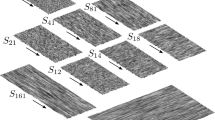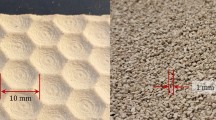Abstract
Direct Numerical Simulation (DNS) is used to study fully developed turbulent flow over a number of irregular rough surfaces in periodic plane channels. DNS in minimal channels, initially proposed by Chung et al. [7], is examined and generalized in the present research. To this end the DNS results for flow in channels with reduced streamwise and spanwise sizes (so-called minimal channels) are compared to those in large channels. Generation of roughness is based on a mathematical algorithm in which the height power spectrum of the roughness along with its height probability distribution can be prescribed (hence the term “pseudo-random” rough surface). This approach allows generation of roughness samples that may be considered as surrogates of realistic roughness and can replace the costly process of scanning industrial surfaces.
Access this chapter
Tax calculation will be finalised at checkout
Purchases are for personal use only
Similar content being viewed by others
References
R. Webb, E. Eckert, R. Goldstein, Heat transfer and friction in tubes with repeated-rib roughness. Int. J. Heat Mass Transf. 14(4), 601–617 (1971)
K. Flack, M. Schultz, J. Barros, Skin friction measurements of systematically-varied roughness: Probing the role of roughness amplitude and skewness. Flow Turbul. Combust. 104, 317–329 (2019)
J. Nikuradse, Strömungsgesetze in Rauhen Rohren (VDI-Verl., Berlin, 1933). (ISBN 0341-7247)
A. Townsend, The Structure of Turbulent Shear Flow. (Cambridge University Press, Cambridge, 1980). (ISBN 052120710). http://www.loc.gov/catdir/toc/cam032/74014441.html
P. Forooghi, A. Stroh, F. Magagnato, S. Jakirlic, B. Frohnapfel, Toward a universal roughness correlation. ASME J. Fluids Eng. 139, 121201 (2017)
S.B. Pope, Turbulent Flows (Cambridge University Press, Cambridge, 2000)
D. Chung, L. Chan, M. MacDonald, N. Hutchins, A. Ooi, A fast direct numerical simulation method for characterising hydraulic roughness. J. Phys. Conf. Ser. 708, 012010 (2016)
F. Pérez-Ràfols, A. Almqvist, Generating randomly rough surfaces with given height probability distribution and power spectrum. Tribol. Int. 131, 591–604 (2019)
M. Chevalier, P. Schlatter, A. Lundbladh, D.S. Henningson, SIMSON-a pseudo-spectral solver for incompressible boundary layer flow. Technical report TRITA-MEK, pp. 1–100 (2007)
D. Goldstein, R. Handler, L. Sirovich, Modeling a no-slip flow boundary with an external force field. J. Comput. Phys. 105(2), 354–366 (1993)
J. Barros, M. Schultz, K. Flack, Measurements of skin friction of systematically generated surface roughness. Int. J. Heat Fluid Flow 72, 1–7 (2018)
K. Flack et al., Skin-friction behavior in the transitionally-rough regime. Int. J. Heat Fluid Flow 61, 21–30 (2016)
Author information
Authors and Affiliations
Corresponding author
Editor information
Editors and Affiliations
Rights and permissions
Copyright information
© 2021 The Author(s), under exclusive license to Springer Nature Switzerland AG
About this paper
Cite this paper
Yang, J., Stroh, A., Forooghi, P. (2021). Simulation of Flow over Pseudo-Random Rough Surfaces. In: Nagel, W.E., Kröner, D.H., Resch, M.M. (eds) High Performance Computing in Science and Engineering '20. Springer, Cham. https://doi.org/10.1007/978-3-030-80602-6_25
Download citation
DOI: https://doi.org/10.1007/978-3-030-80602-6_25
Published:
Publisher Name: Springer, Cham
Print ISBN: 978-3-030-80601-9
Online ISBN: 978-3-030-80602-6
eBook Packages: Mathematics and StatisticsMathematics and Statistics (R0)




